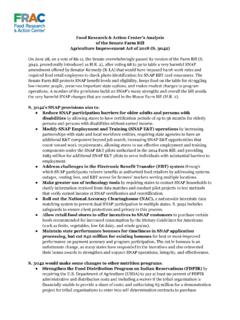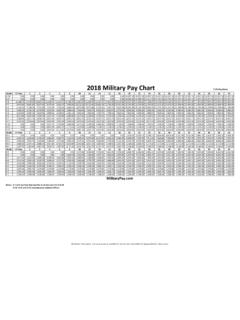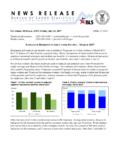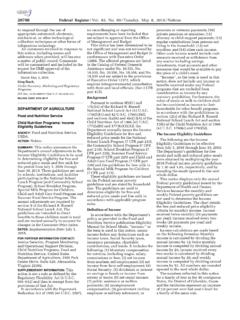Transcription of The Agriculture and Nutrition Act of 2018 - frac.org
1 Food Research & Action Center s Analysis of the House Farm Bill The Agriculture and Nutrition Act of 2018 ( 2) The House Farm Bill, 2 - The Agriculture and Nutrition Act of 2018 , squeaked by on June 21 by a vote of 213 to 211 after initially failing to pass on May 18. 2 would take food out of the refrigerators and off the kitchen tables of households participating in the Supplemental Nutrition Assistance Program (SNAP) and set up an unproven workforce bureaucracy that would burden states and participants alike. Low-income seniors, people with disabilities, veterans, unemployed adults, and families with children already are struggling to purchase adequate diets throughout the month on low wages and modest SNAP benefits.
2 Cutting SNAP eligibility and reducing benefits will increase hardship and food insecurity and depress purchasing power that drives local economic activity across America. Major provisions: 2 cuts SNAP benefits by more than $20 billion over 10 years, including the following changes: $5 billion SNAP food benefits are cut by eliminating a state option (broad-based categorical eligibility) that allows states to adjust SNAP asset tests and screen families with gross incomes modestly above 130 percent of the poverty line to determine if their net incomes (after expenses for shelter, childcare, or certain other basic expenses) qualify them for a SNAP benefit.
3 Many states have chosen this simplification The proposed change would particularly take SNAP away from low-income working people with children, exacerbate the cliff effect when they improve their earnings, cause 265,000 children to lose access to their free school meals,ii and significantly increase states administrative costs and burdens. $ billion SNAP food benefits are cut by slashing benefits for non-elderly SNAP households struggling to pay for utilities and food ( heat and eat ) by severing states coordination of SNAP benefits with low-income energy payments. $ billion SNAP food benefits are cut by expanding harsher work requirements to more unemployed or underemployed work-capable adults aged 18 to 60, including for the first time adults aged 50 60 and adults with dependents aged 6 and above who must work, participate in an employment and training program, or participate in a work program for 20 hours a week (fiscal year 2021 2025) and 25 hours per week (fiscal year 2026 and thereafter) or lose SNAP eligibility.
4 Individuals who do not meet the required weekly hours will only have one month to comply or lose SNAP food benefits for 12 months; on a subsequent failure to meet the weekly work-hours requirement, the participant would lose SNAP food benefits for 36 months. The bill also would weaken our nation s Nutrition safety net by creating additional barriers to SNAP participation, including mandating child support cooperation to receive benefits (an option 45 states and the District of Columbia have chosen not to take); allowing more identifying SNAP client information, such as biometrics to be put onto electronic benefit transfer (EBT) cards, which, based on limited implementation of photos on EBT cards, risks increased stigma and barriers for SNAP clients in redeeming benefits; implementing a nationwide duplicative enrollment database.
5 Reducing the amount of time before a state can store unused benefits offline; and reducing the amount of time before which benefits will be expunged if not spent. i See the USDA Food and Nutrition Service (FNS) chart at: ii Check out FRAC s resource on the connection between SNAP and school meals: 2 will redirect funding from SNAP food benefits to roll out an unproven workforce bureaucracy. 2 requires each state to offer a SNAP Employment and Training (E&T) slot to every eligible participant. While it increases E&T program grant funding from the current $90 million a year to $250 million in fiscal year 2020, and $1 billion in each year thereafter, that funding level is insufficient to provide meaningful and robust job training programs and support services such as childcare and transportation.
6 Evaluation results from 10 pilot SNAP E&T programs authorized in the 2014 Farm Bill are not yet available to inform this approach. States would face new administrative burdens and costs and are not well-positioned to ramp up their SNAP E&T programs adequately enough to serve those affected by the 2 time limits. As amended on the House floor, 2 got even worse: it further restricts states ability to waive the arbitrary SNAP time limit on people who do not prove sufficient regular weekly work hours, including in areas with insufficient jobs; opens SNAP eligibility decisions up to for-profit private contractors to make; imposes a lifetime ban on individuals convicted of certain felonies who are making new starts after serving their sentences; allows multivitamins and other dietary supplements to be purchased with SNAP, exacerbating the inadequacy of benefits.
7 And requires the USDA to review the current school meal Nutrition standards regulations with an eye to rolling back the existing standards. 2 s huge cuts to SNAP food benefits are not cured by modest reinvestments to keep the Nutrition title cost neutral (approximately $5 billion over 10 years). These include $116 million to allow up to $500 of Basic Allowance for Housing for military families living off-base to be excluded when determining SNAP eligibility, and allow those households to claim expenses that exceed that threshold for purposes of their shelter deduction. The $500 per month exclusion is woefully inadequate to address food insecurity among military families.
8 $ billion to increase the earned income deduction from 20 to 22 percent when determining SNAP eligibility. $26 million to make the current option for states to provide a simplified homeless housing deduction a requirement. $201 million to increase the maximum allowable value of assets from $2,000 to $7,000 for most participating households, and from $3,000 to $12,000 for households with a senior or person with disabilities; increase the vehicle allowance that is excluded from asset calculations; and exclude up to $2,000 in savings from household assets when determining eligibility for SNAP. This amount pales in comparison to the existing authority states have to disregard assets and vehicle values when processing SNAP applications.
9 $895 million to make the current option a requirement for states to provide transitional SNAP benefits to households for five months after they have left cash assistance from the Temporary Assistance for Needy Families program. Other programmatic changes to the Nutrition Title in 2 include a $499 million increase in funding for The Emergency Food Assistance Program (TEFAP) over 10 years, with increased funding for fiscal year 2019 2023 and the establishment of a Farm-to-Food Bank fund. a $472 million increase in funding over the next 10 years for the Gus Schumacher Food Insecurity Nutrition Incentive Program, formerly the Food Insecurity Nutrition Incentive Program (FINI).
10 A $632 million increase for SNAP Nutrition Education (SNAP-Ed) over the next 10 years, but shifting program operation from state agencies to land grant universities and mandating USDA National Institute of Food and Agriculture (NIFA), which currently operates the Expanded Food and Nutrition Education Program (EFNEP), to partner with USDA-FNS on SNAP-Ed implementation. 2 changes the funding structure of state allocations for SNAP-Ed by basing it on state SNAP participation only, no longer on a combination of 50 percent of state SNAP participation and 50 percent on the funding level states received in fiscal year 2009.















